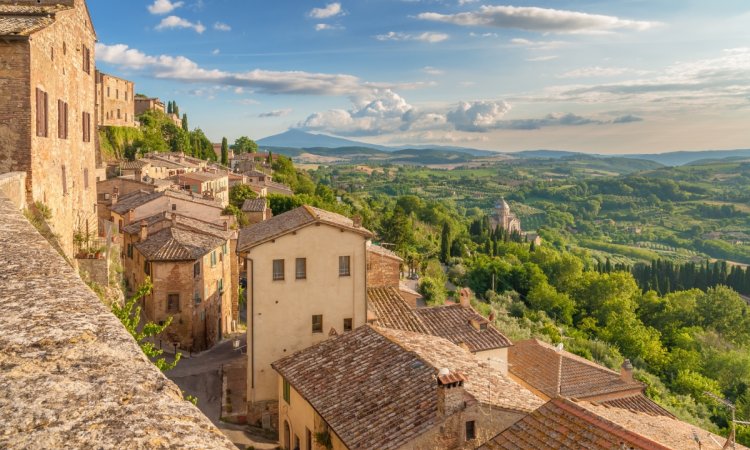
Unlike any other sort of transportation, traveling by train means you don’t have to wait for arrival at the destination to get your tourist on; you get a comfy, front row seat for the whole country.
The popular train ride from Florence to Rome is no exception. Put down your phone, tuck that riveting new novel back in your bag, and look out the window. Discover the towns, landscapes and landmarks when you travel from Rome to Florence (or from Florence to Rome) by train.
First, the practical stuff.
What’s the distance between Rome and Florence?
The distance from Rome to Florence is 144 miles (231 km). The journey takes approximately an hour and a half to an hour and 45 minutes for a high-speed train from Rome to Florence, and around four hours for slower, regional trains. A ticket on a Trenitalia Freccia train will cost between $30 and $70 USD.
If you’re planning a day trip and want to get to Florence fast, make sure the button is set to direct trains when you book your train with Italiarail. Unless of course, you have some time, then taking the regional train will allow you to see some of the magnificent medieval villages hiding in plain sight along the way.
What to see on the train from Florence to Rome
First and foremost, taking the train from Rome to Florence and vice versa will give you a window seat onto the Tuscan countryside, one of the most beautiful landscapes in the world. Little islands of cypress trees surrounded by seas of green, rolling hills; fortified farms; medieval hill-top villages with their ancient towers and churches reaching out to the blue Tuscan sky. When people imagine Italy, this is what they dream of.
Whether you decide to high-tail it to Florence or Rome on the Alta Velocità trains or take the longer, more scenic, regional train (that with a Eurail pass will allow you to stop at different stations along the way) look out for these picturesque towns dotting the Tuscan landscape on your journey.
Orvieto
About an hour away from Rome, Orvieto is the quintessential fortified hilltop, medieval town. Situated on a large, volcanic plateau about 1000 feet from the valley below, it dominates the landscape. If you decide to stop in Orvieto, the train lets you off at the generic, nothing-special, new town. However, take the funicular up to the old town and step into history. Narrow, winding streets, a colorful gothic cathedral, and a pedestrian-only town square filled with lively cafes awaits you.
Montepulciano
Just under 200 kilometres from Rome, you’ll see Montepulciano sitting on its limestone throne in the distance. Another beautiful example of a hilltop medieval-renaissance town, Montepulciano has become very popular with a certain demographic after the Twilight sequel, New Moon, was filmed in Montepulciano. Even if vampires aren’t your thing, Montepulciano will wow you with its Renaissance architecture and amazing wine and food. The train station is a few miles from the city center and connected by bus.
Cortona
Another beautiful Tuscan hilltop town founded by the Etruscans, Cortona has also found fame more recently as the location for Francis Mayes’ book Under the Tuscan Sun: At Home in Italy. The town is surrounded by walls that date back to the Roman Empire. Like the other towns, its city center is defined by the 13th century town hall, bell tower and churches. If you wander outside the city walls and walk for about 45 minutes, you will come to an old medieval convent where it is claimed Saint Francis stayed while he preached in the area. About an hour away from Florence, you can reach Cortona by getting off at the Terontola-Cortona station and then taking a bus to the town a few miles away.
Arezzo
Arezzo is a hidden gem in the Tuscan countryside, about 50 miles from Florence. Less populated by tourists, it is known for housing the famous Piero della Francesca fresco cycle, the Legend of the True Cross, in the Church of San Francesco and has one of the best Etruscans museums around. It is also the little, medieval village where Roberto Benigni’s film, Life is Beautiful, was filmed. You can walk to the town center from the train station. Once there, go to the tower you glimpsed from the train, climb up and take in the magnificent Tuscan landscape. Then sit under the arcade in the Piazza Grande and watch the townsfolk while you sip on some local red wine.
San Giovanni Valdarno
As you get nearer to Florence, keep your eye out for this medieval town. Founded in 1296 by the Republic of Florence, San Giovanni Valdarno boasts many of the same architectural features as Florence: red-tiled roofs, an imposing domed cathedral and tower in the center, and many renaissance palaces. Stop in front of the municipal palace from the 13th century with its dizzying display of ceramic heraldry and try to count them all! The birthplace of the Renaissance painter Masaccio, the town holds many of his works as well as the architect Arnolfo di Cambio.
Whether you take the high-speed train between Florence and Rome or whether you decide to take the slower route, the train ride between Rome and Florence is more than just convenience — it is a scenic Tuscan tour featuring Italy’s most iconic scenery. Visit Italiarail for more information on train times, ticket prices and to book your Rome to Florence train tickets today.


